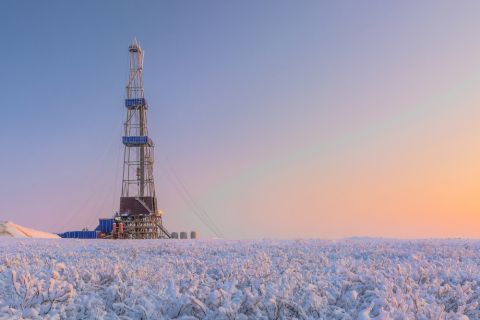
A pumpjack produces oil in the Argentine dessert. (Source: Lee Torrens, Shutterstock.com)
The rush is on at Vaca Muerta. Despite the high costs of exploration, the lack of suitable infrastructure in western Argentina and political barriers to production, companies are beginning to make substantial investments in one of the world’s largest potential shale plays. Chevron, ExxonMobil, Royal Dutch Shell and Total have begun making sizable financial investments in the sleeping shale giant.
A study by Ryder Scott estimated that the Vaca Muerta Shale holds more than 21 Bboe, and initial exploration efforts suggest there may be more than 927 MMboe in unconventional hydrocarbons. The U.S. Energy Information Administration (EIA) estimated Argentina’s total shale hydrocarbons might be 30% larger than the estimated tight oil reserves in the U.S.
According to state-run YPF, Vaca Muerta covers 7.4 million acres and has the potential to increase Argentina’s hydrocarbon production by 50%, which could lead to the country eventually becoming a net energy exporter. YPF estimated as many as 50,000 wells could be drilled in the area, although, according to Rystad Energy, only about 150 wells had been drilled by late 2016.
Replicating North American shale
Vaca Muerta has been compared in composition to the Eagle Ford in terms of depth, thickness, pressure and mineral composition, according to the EIA. Vaca Muerta wells have so far shown lower initial decline rates than similar wells in the U.S., and after 90 days of production the Vaca Muerta compares favorably in terms of volume to similar wells in the Bakken or Delaware Basin, according to Rystad.
In 2016 horizontal wells in the Vaca Muerta initially produced about 450 boe/d during their first 90 days, while wells in the Delaware Basin produced about 490 boe/d during the same period, the company reported.
In 2015 Argentine President Mauricio Macri said he wanted the country to make efforts to increase its shale production activity, looking to replicate the success seen in North American tight oil production. YPF has estimated that the Vaca Muerta Field needs about $42 billion in investments to increase production by 50%. Some of those investments are on their way—nearly $4 billion worth so far this year.
In mid-July TPF SA, Total, Wintershall Energia and BP announced a $1.15 billion joint investment to increase shale gas production. The investment is expected to double the natural gas production to 4.5 MMcm/d (158 MMcf/d), an increase from the current rate of 2.2 MMcm/d (77.6 MMcf/d). Total said the company was encouraged to move forward with the project after Argentina’s government in January locked in a guaranteed gas price of $7.50/MMBtu through 2020, more than doubling similar U.S. gas contracts.
“The development will benefit from the use of existing facilities, enabling production of shale gas at a very competitive cost,” said Arnaud Breuillac, president of E&P for Total. “This is one of 10 major projects that [E&P] plans to sanction in 2017-2018, taking advantage of the favorable low cost environment, which is now approved and will contribute to the group’s production growth beyond 2020.”
The joint venture involving Total came a few months after Argentina’s Tecpetrol said it would invest $2.3 billion in Vaca Muerta Shale fields through 2019. Meanwhile, XTO, ExxonMobil’s shale oil and gas operating arm, will have invested $750 million in Vaca Muerta and started production in May, Neuquén province governor Omar Gutierrez said in April.
One of Vaca Muerta’s largest operators has been Chevron through its wholly owned subsidiary Chevron Argentina S.R.L. Chevron Argentina is the seventh-largest oil producer in the country, with operations in the Neuquén Basin and waterfl ood projects in the El Trapial Field. In 2014 Chevron announced agreements to develop shale oil and gas at the Loma Campana Field in the Vaca Muerta formation. Chevron Argentina holds an 85%- owned and operated interest in one concession that covers 94,000 net acres in Vaca Muerta that holds the potential for both conventional and unconventional production.
YPF CEO Miguel Galuccio said at an industry conference in Uruguay that the Loma Camapana Field is producing about 45 Mbbl/d, which accounts for nearly all of Argentina’s shale production.

Infrastructure constraints
Although Vaca Muerta is seeing interest in investments increase, particularly this year, barriers to a full-scale production frenzy such as has been seen in the Permian Basin remain significant for operators. For one, Vaca Muerta is located in a remote region of Argentina—the Nequén Basin is more than 1,126 km (700 miles) from Buenos Aires and 563.7 km (350 miles) from Puerto Rosales. The 321.8-km (200-mile) Route 7, the main road in and out of the Neuquén, has one lane each way.
Galuccio said the high cost of drilling and completing a well—about $11 million—isn’t economical at sub-$50 oil. YPF drilled its wells with the expectation that they would be profitable at $84/bbl and with wells that cost between $6.5 million and $7 million.
In addition, large quantities of proppant have yet to be found locally, and equipment such as drilling rigs, pipeline and valves must be imported together from two to three hours away. Argentina also implements a special tax on imported equipment, which results in equipment costs running 20% to 30% higher than in the U.S. The region doesn’t offer any pipeline or railways, and all water must be trucked to production sites. These high costs have forced companies like Oxy, Pioneer, EOG Resources, Apache Corp. and Medanito to sell off their Vaca Muerta assets, primarily to YPF, according to Rystad.
Political challenges
In addition to high costs, operators in the past had to deal with challenging labor demands. Until January, when the country’s labor union relaxed its rules, operators often were forced to employ more workers on a rig than were needed.
The government allowed a 15-year export tax on oil to lapse this year, which helps improve financial prospects.
Although the Argentine government is keen on ramping up production and attracting interests from global operators, only two of Vaca Muerta’s 19 awarded concessions have begun producing. Energy research and consulting firm Stratas Advisors reported that for production to ramp up in the Vaca Muerta in the long term—beyond 2020—several conditions need to be met, including high investor confidence in the stability of Argentina’s long-term policies, significant cost reductions, infrastructure improvements and the recovery of oil prices.
Still, with the vast recovery potential at Vaca Muerta, it could eventually out-produce U.S. shale production, said Shu Feng, director of upstream at Stratas Advisors.
“In the long-term, [Argentina] is likely to replicate U.S. shale success in Vaca Muerta, but it’s going to take the [Argentine] government to build a strong, stable geopolitical environment,” Feng said.
Recommended Reading
Wayangankar: Golden Era for US Natural Gas Storage – Version 2.0
2024-04-19 - While the current resurgence in gas storage is reminiscent of the 2000s —an era that saw ~400 Bcf of storage capacity additions — the market drivers providing the tailwinds today are drastically different from that cycle.
Biden Administration Criticized for Limits to Arctic Oil, Gas Drilling
2024-04-19 - The Bureau of Land Management is limiting new oil and gas leasing in the Arctic and also shut down a road proposal for industrial mining purposes.
SLB’s ChampionX Acquisition Key to Production Recovery Market
2024-04-19 - During a quarterly earnings call, SLB CEO Olivier Le Peuch highlighted the production recovery market as a key part of the company’s growth strategy.
PHX Minerals’ Borrowing Base Reaffirmed
2024-04-19 - PHX Minerals said the company’s credit facility was extended through Sept. 1, 2028.
Exclusive: The Politics, Realities and Benefits of Natural Gas
2024-04-19 - Replacing just 5% of coal-fired power plants with U.S. LNG — even at average methane and greenhouse-gas emissions intensity — could reduce energy sector emissions by 30% globally, says Chris Treanor, PAGE Coalition executive director.





